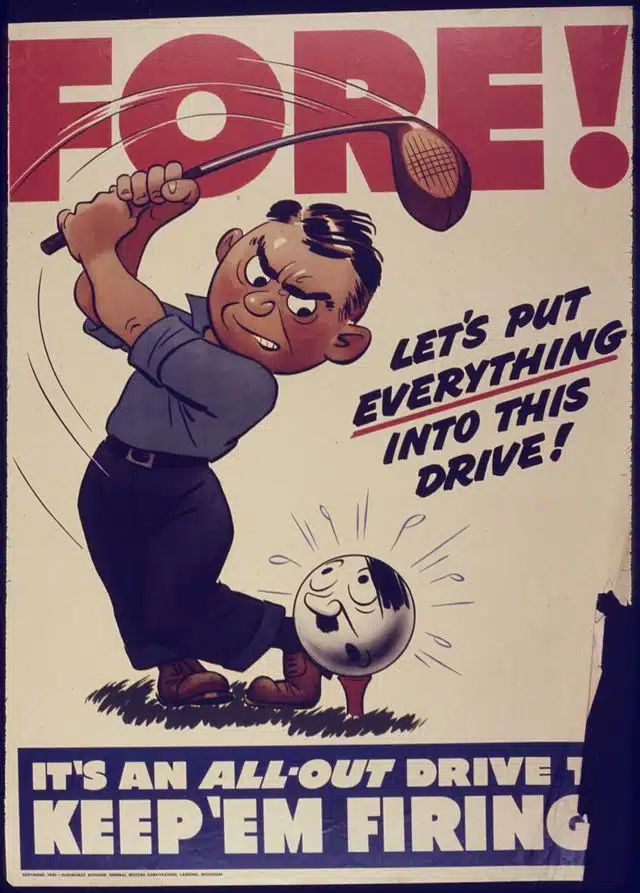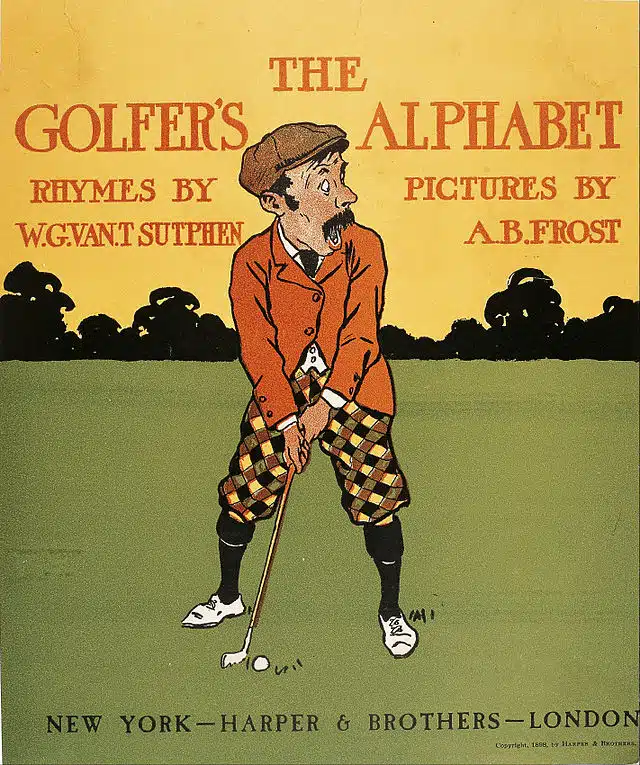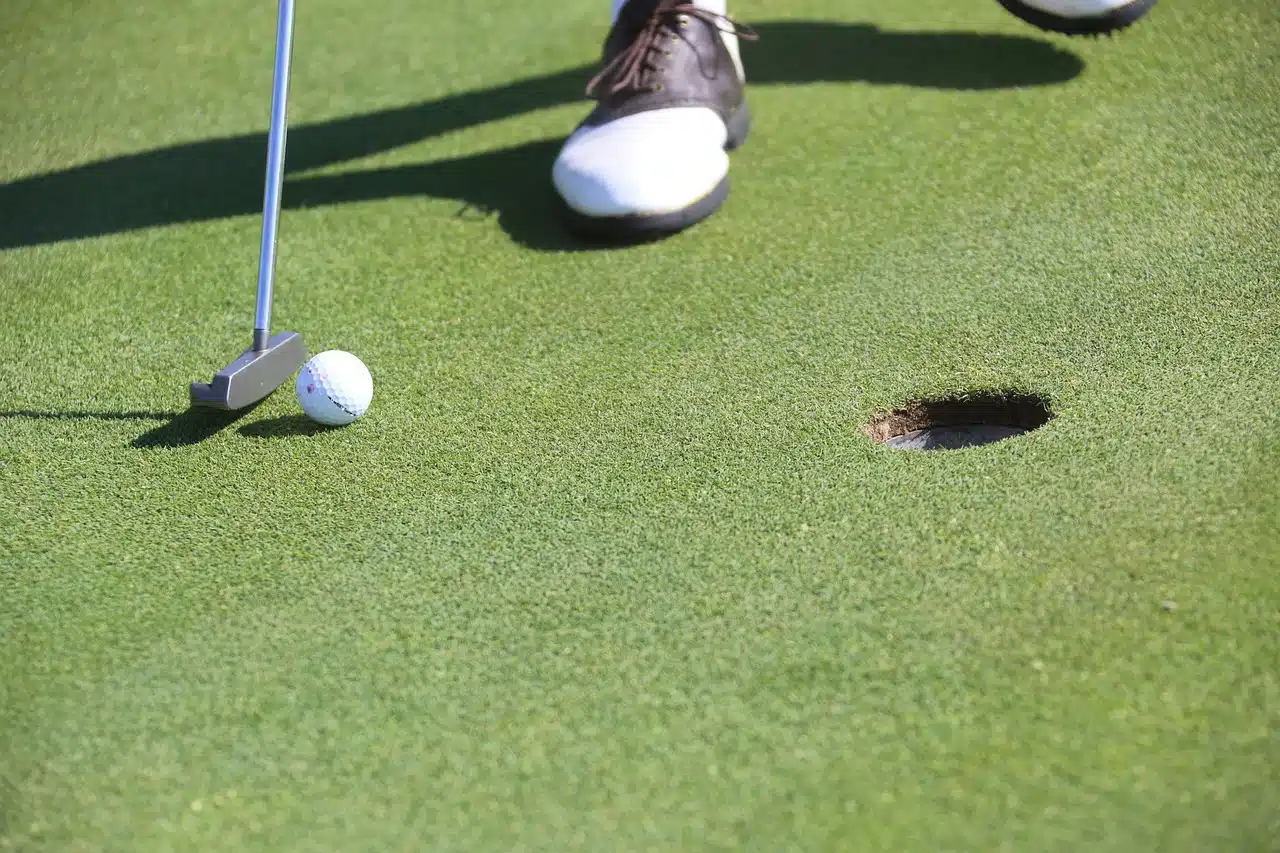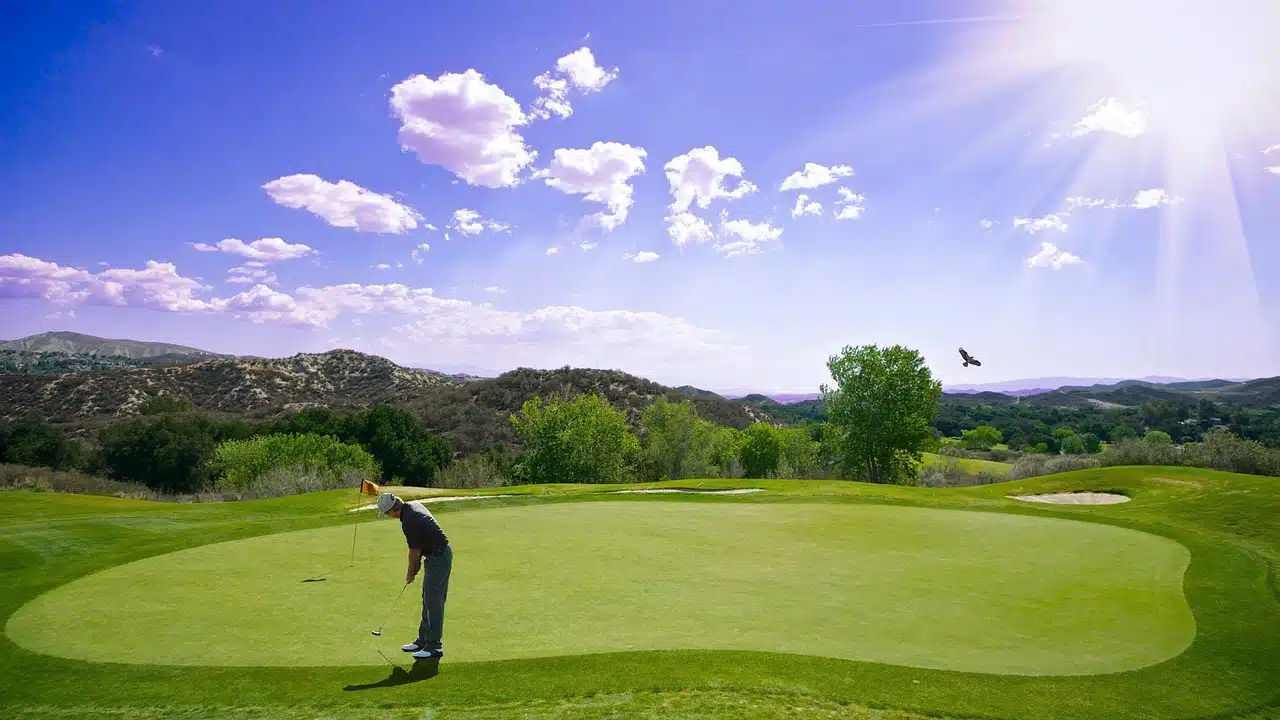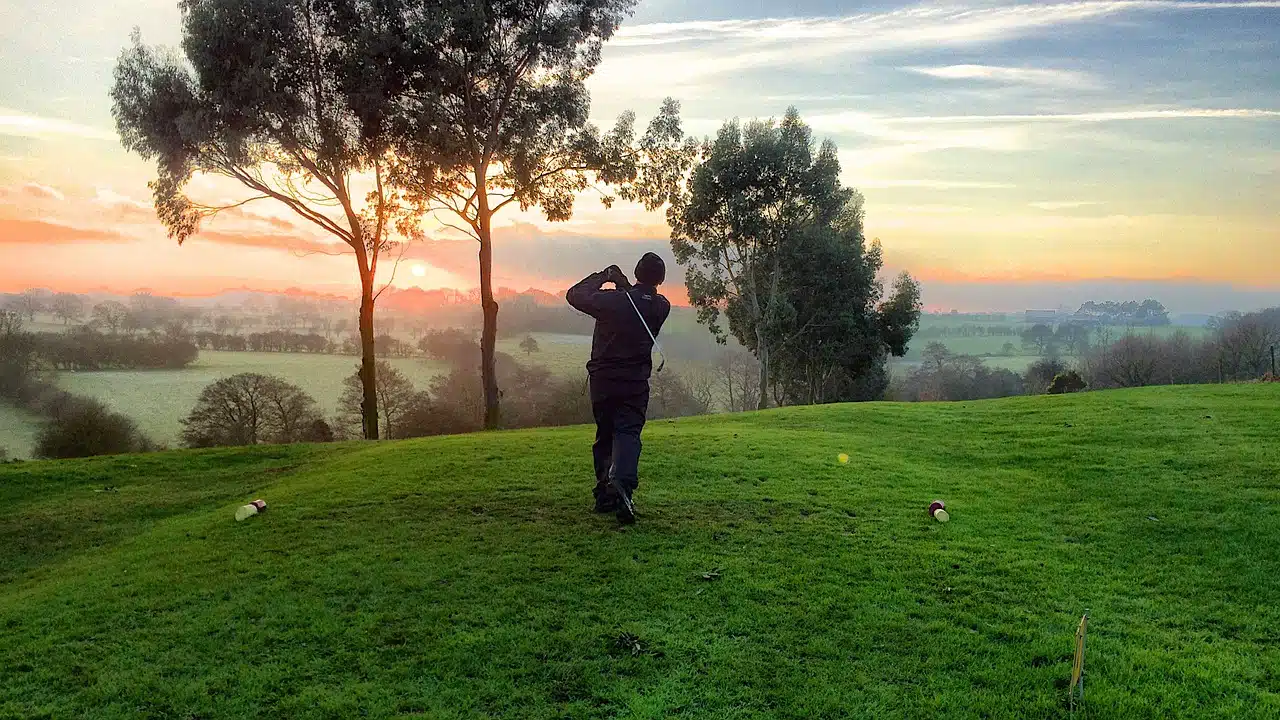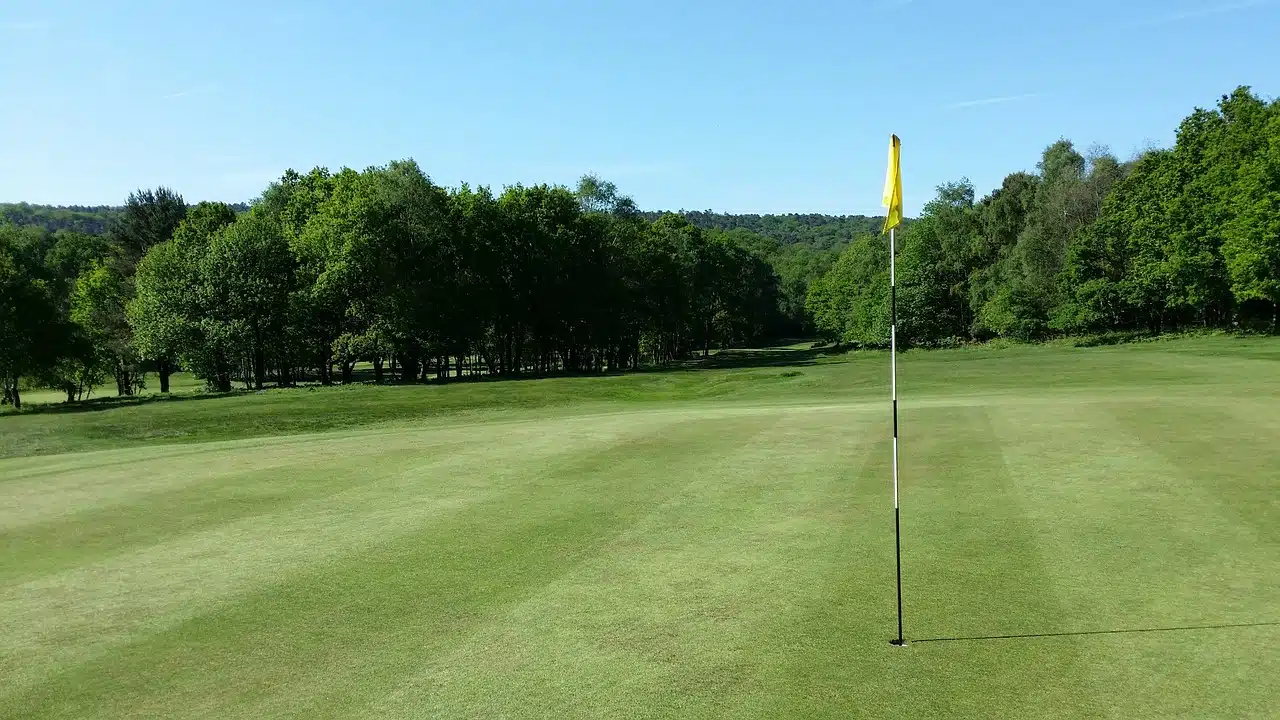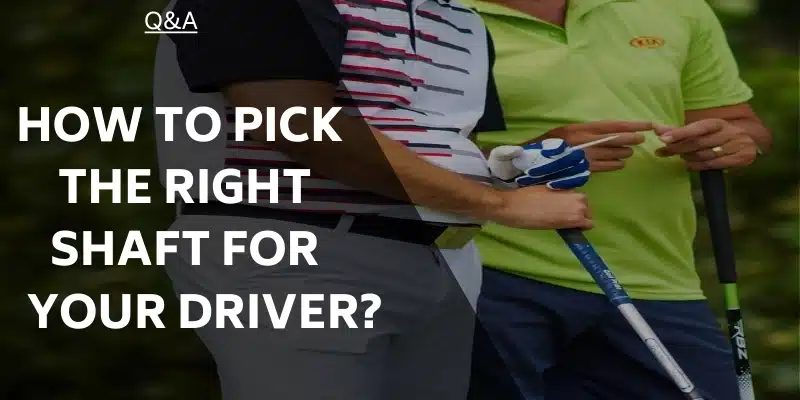Someone new to the game might initially find many golf terms confusing. I know this was the case for me, and I was surprised at how many special terms golf had.
Given the age and popularity of the sport, golf probably has quite a few more than many other sports. The first evidence of modern golf can be traced back to the 1740s, which built a rich golf language. Even seasoned players often come across a term of reference that is new to them, and this list of golf terms should help.
To demystify the sport and give players a better understanding of the special terms, we will take you through some of the most important and commonly used golf terms. This will give you more confidence on the course and allow you to focus on your game without deciphering what the other person said.
For convenience, we have put this complete A to Z list of all Golf Terms/Lingo used in golf. There are over 250 terms of golfing terminology on this list.
Feel free to return to it whenever you have questions since it takes time to memorize all the terms since there are many golf terms to know.
The Most Common Golf Terms for Beginners
First, let’s look at the most important golf terms and meanings that a beginner should learn first, but remember that we have an extensive list of other terms you may want to check out even after. These are the most common golf terms that every beginner should know!
JUMP TO – A B C D E F G H I J K L M N O P Q R S T U V W X Y Z
A
Ace – One of the important golf course terms, you’d score an ace whenever you score a hole-in-one. Golfers sometimes call this an ace. You hit the ball from the tee to the hole in one stroke. Only 1% to 2% of all golfers will score an ace in a year, which makes it a rare occurrence.
Address – How you stand and position your club before a shot is known as address. Remember not to accidentally cause the ball to move when addressing the ball, as this will result in a penalty of one stroke.
Albatross – Occasionally called a double eagle, an albatross is a score of three under par, and an awesome 2 on a par-5 or a hole in 1 on a par–3 would give you a brilliant result, but like an ace. It’s quite rare. Most golfers will never even get an albatross. The exact origins are unclear, but the term has been around since at least 1929, and it’s one of the basic golf terms.
B
Backswing – As the term suggests, this is simply the action taken when swinging back before striking the golf ball. It is important for distance and accuracy.
Backspin – Spin is very important in most aspects of golf, and you will often come across the term when comparing clubs or golf instructions. Simply put, more backspin will give you a high ball with a fair amount of control.
Back Nine – This refers to the last 9 holes of a typical 18-hole course, also known as heading in.
Birdie – A hole where you score one stroke under par is a birdie. It is generally accepted that the term officially originated at the Atlantic City Country Club in 1903. – read more about the birdie.
Blade – This is a style of iron that, while once the only option in past years, is now mostly used by better players. It has a compact “blade” shaped head with relatively even weight distribution on the club’s rear.
Bogey – This is simply a score of one over par on a hole. The term is said to have originated from a song, “The Bogey Man,” which was popular in the British Isles early in the 1890s.
Bunker – The much-dreaded bunkers, also known as sand traps, are hazards that are a depression in the ground containing sand. They can either be near the green or on the fairway.
C
Caddie – This term commonly refers to a professional you hire to carry your clubs around and advise you. The caddie can tell you how to approach a shot in such a way as to lower your score.
Center Shaft – Shaft comes out of the center of the putter head closer to the sightline than the heel. Most center-shafted putters will be face-balanced with even weight distribution between your heel and toe.
Cup – Slang for the hole on the green.
D
Dogleg – A straight fairway with a sharp bend left or right is referred to as a dogleg.
Dog Lie – Bad lie normally in the rough.
Double Eagle – also called an albatross. It occurs when a golfer achieves a 3-under par on a hole.
Double Bogey – One of the golf scoring terms, a score of two above par on a hole is a double bogey.
E
Eagle – A score of two under par on a hole is known as an eagle. This is considered a good score since it is better than what a scratch golfer would get.
Elevated Green – A green that is at a higher elevation compared to the fairway or tee box.
F
Forgiving – A characteristic of beginner golf clubs to minimize the swing mistakes of golfers.
Fairway – The shorter mowed middle of the fairway between the tee box and the green that runs from 30 to 50 yards. The word’s origins are unclear, but many believe it derived from a nautical term for a clear and safe channel. This is one of the important golf terms to know.
Fore – To warn players ahead of an errant ball or potential danger, a player should shout “Fore” as a warning. The term is Scots in origin and dates back as early as 1881.
G
Green – The green is the end of each golf hole where the target cup and flag are situated. They vary in size and shape, and grass, although short, can differ depending on conditions.
Green in Regulation – This occurs when the golf ball is on the green, and the player is putting for a birdie or better.
Green Fee – The cost of playing a round of golf at a certain golf course.
H
Handicap – This is a numerical system based on past results that measure the potential and level of a golfer’s skills. It allows players of different skills and abilities to compete on a relatively even footing.
L
Long Game – In a long game, in contrast to a short game, you must deliver on power and distance to reach the putting green in as few strokes as possible. A short game, in contrast, depends on you using finesse and accuracy to put the ball into the hole in as few strokes as possible.
M
Mulligan – While not recognized or allowed in the rules of golf, mulligans are a free second shot. They are generally limited to tee shots and usually the first tee. When given a mulligan, the player does not incur a penalty. This is usually given after a golfer’s first shot goes wrong.
P
Pace – Golf is a leisurely sport, but players are often behind you. One must ensure a decent pace to not hinder other golfers from enjoying the game. Sometimes, golfers let a faster player go-ahead to keep a more leisurely pace.
Par – One of the common golf terms, par, is the standard or average score an accomplished golfer should make per hole. The distance of the hole largely determines it. Par will range from 3 for shorter holes to 5 for longer holes. The course itself will also have a par, which is the combined total of the par for all 18 holes. Most courses will sit between 70 and 74, with 72 being the most common.
Pin – An informal term for the flagstick.
R
Rangefinder – This modern digital device will scan the course to determine the distance to the green or the flag.
S
Short Game – This refers to shots close to or around the green. It includes pitch shots, chips, and putting.
Semi-Rough – The first cut of grass off the fairway.
Stroke – Any swing with a golf club from a golfer addressing and trying to hit the golf ball.
Stroke Play – This format, sometimes called medal play, is based on the total number of strokes over a round or a fixed number of rounds.
U
Unplayable – Apart from on the tee, a player can declare his ball unplayable. The golfer can then drop the ball further from the hole or within two club lengths of where it landed. A one-stroke penalty will be incurred when this is done. If this occurs in a haze, the drop has to be made in the same hazard.
A Complete List Of Golf Terminology
JUMP TO – A B C D E F G H I J K L M N O P Q R S T U V W X Y Z
A
Alignment – This refers to the position of the player’s body relative to the intended target. Good alignment is critical for accurate shots.
Apron – The section of the fairway that leads up to the front of the green. They cut the grass at the apron slightly higher than what you’d see on the greens, but it remains lower in height than the grass on the fairway.
Approach – Shots played that is intended to land on the green are known as approach shots.
Approach Wedge – A wedge that is the loft between a sand wedge and a pitching wedge. Normally, the loft is around 52 degrees.
Away – The player farthest away from the hole and up to play.
B
Ball Marker – A device used on the green to line up a putt and get out of the way of the other players on the green.
Banana-Ball – A hard slice that curves very hard. For right-handed golfers, the ball goes from left to right.
Bandit – A golfer that has an artificially high handicap compared to their actual ability to shoot low scores. This is someone who deliberately plays at a higher score than they know they can do better than.
Baseball Grip – A type of grip that resembles a baseball bat grip. Others might call it a 10-finger grip.
Below the Hole – A term that refers to a putt where the hole is at a higher elevation than the ball.
Big Dog – You will sometimes hear golfers call their drivers a “Big Dog.” This slang term is used in golf, and it means the biggest and longest club in their bag that hits the ball the farthest. It is also the most fun to hit with, but if you strike the ball wrong, it can send the ball the most.
Bite – A term golfers use when the ball hits the green and immediately stops rolling because of high backspin. The ball stopped abruptly due to a bite.
Bladed Shot – A chip shot from just off the green purposely hit with the bottom of the club and often played from when the ball rests against the collar of the green. Runs like a putt.
Blind Shot – A situation where a golfer can’t see the fairway or green they aim for.
Block – A shot for a right-handed golfer that goes straight to the right due to the open club face.
Bounce – Along with launch angle. This is a measurement for wedges. You’d think of it as the lowest part of the sole or the trailing edge of the golf club. This relates to irons, but it especially has to do with wedges.
Bump and Run – A chip shot around the green involving a low-lofted iron. This type of chip is great for a large part of the green.
Best Ball – A type of golf format between players in a group. Only the best score is taken at the end of each hole.
BOX – Exclamation when holing a putt.
Break – The term describes the curvature of a ball on the putting green. It is based on the slope and grain of the green and other factors, such as wind.
Burn – A Scottish word for a stream, creek, or river alongside or across the fairway. Typically, you see the burn used as a defense for approach shots.
Businessman’s Grip – Often seen on a golfer who does not play regularly. The vs in the hands are not in sync (the right hand is too far on top of the shaft, and the V points to the right shoulder instead of the left).
C
Calcutta – In a golf Calcutta event, every team or golfer gets put up for auction, where you bid on them. Let’s say that the player that you chose goes on to win. You would receive the highest payout from the pot. It’s a common betting strategy in golf, even though the USGA doesn’t let amateur players compete in a golf Calcutta.
Cat Box – A humorous golf name for a bunker. The grainy sand of it reminds one of the cat’s litterbox.
Carpet – Another golf term for the short grass on a putting green.
Carry – This term refers to the distance the balls travel through the air. It is important when you need to get over obstacles or hazards.
Cavity back – These irons are designed to be more forgiving than blades. The cavity back allows for perimeter weighting allowing off-center hits to still travel a fair distance without too much loss of direction. They offer less control and shaping ability than blades but are preferred by the average golfer and the beginner.
Center of Gravity – While this term can also be used to talk about a player, it is generally related to the design and balancing of the golf club. To keep the concept simple, the farther back and lower the center of gravity (CG), the higher the trajectory according to the loft angle. This will give golfers an easier launch with good backspin. Low-handicap players do not need this advantage as much and prefer a progressive CG with a higher CG on the longer irons.
Chip – This is a short shot to get on the green and close to the pin if not in the hole. It is generally a low-trajectory shot. A chip and run is even lower; as the name suggests, the ball runs along the ground most of the distance.
Choke Down – Choking down refers to gripping the club lower down on the shaft. It is often used on shorter approach shots for greater control. You will sometimes hear the terms choking down or choking up interchangeably in golf. The golfer’s hands moved farther away from the butt-end of the grip.
Chunk – A mishit golf shot where the golf club makes contact with the ground before the golfer hits the ball.
Clone Clubs – A clone brand that makes clubs at a more discounted price compared to name-brand golf clubs. These differ from knock-off golf clubs because clone clubs are legal, but a knock-off club is illegal. Knock-off clubs get sold under the pretense of being the same as the original manufacturer, which makes them illegal. Clone clubs are often made from the same design and materials as the more expensive club.
Collar of the Green – The first cut of grass off the green. This refers to the ring of grass you will sometimes see used to mark around the green, but it isn’t the green itself.
Comeback – Refers to a second putt returning to the hole due to too much power on the previous putt.
Concede – Refers to a situation in match play where a golfer counts an opponent’s putt without them making their own putt. The golfer does this when he realizes he has no chance of winning. It means that the other player concedes that the other player won. The goal of conceding is to speed up the game.
Course Rating – A measurement of how hard a course is based on the skills of a scratch golfer. Sometimes you hear golfers use the slope rating interchangeably, but they aren’t the same thing. The course rating is usually based on the skills of a scratch golfer, whereas a slope rating is based on the skills of a bogey golfer.
Covey – A name for your drawn partners.
Closed Face – Angling the club face towards the body relative to the target will result in a closed face.
Closed Stance – Placing the front foot nearer the target line is a closed stance. It can be used to prevent a slice or play a draw. It could refer to your feet being in a parallel line aimed to the right of your target.
Coefficient of Restitution – Another important consideration when comparing clubs is the Coefficient of Restitution or COR. It is a term used to measure the energy transfer from the clubface to the ball. A higher COR will result in greater speeds and, therefore, more distance. Modern clubs generally have a higher COR than those in the past, and thus it has become a bit easier to get a good distance.
Compression – An important factor to consider when selecting a golf ball is the compression ratio. Softer balls with lower compression are more suitable for people with a slower swing speed. While they will not offer as much control, they will deliver better distance for these players. It is important to match your ball section to your swing speed.
Cut – A golf shot with a high trajectory and moves from left to right for right-handed golfers. They are also referred to as a high fade.
D
Dance Floor – The Green.
De-Loft – Lower the club loft by keeping your hands well in front on impact with a closed face.
Dimples – Golf balls have dimples to improve aerodynamics and regulate spin. The right number and design of dimples for your swing could improve performance.
Divot – When striking the ball, a chunk of turf from beneath the ball is often displaced. The remaining mark or hole is known as a divot. Good etiquette is to repair your divots as you play.
Down the Middle Cyril – Hit your shot straight down the fairway.
Draw – For right-handed golfers. This is a shot that moves from right to left through the air.
Duff – A golf term that refers to a mishit, also called a shank or chunk.
E
Etiquette – Golf is a gentleman’s game, and etiquette is the rules that govern a player’s conduct and behavior.
Even Par – When a golfer’s score matches the 18-hole par for that golf course.
F
Fade – The opposite of a draw, a fade moves from left to right during flight for a right-handed golfer.
Fairway markers – These markers will give you the distance to the center of the green. They are normally color-coded and generally give distance in yards or meters for 250, 200, 150, and 100. The specifics and colors can vary from course to course.
Fat Shot – A fat shot is when the club strikes the ground before the ball. The result is generally poor, and the ball will not travel far.
Ferret – Term for holing a shot from the fringe of the green (usually worth something in a betting game).
Flat Stick – A Putter.
Flex – The measurement of the stiffness of a golf shaft. It could be senior, regular, or shift flex.
Flier – A ball hit from the rough or wet grass that often does not get enough spin and travels further than expected. This is known as a flier.
Flight– The golf ball’s trajectory in the air after a golf shot.
Flop Shot – A flop shot is generally an approach shot hit with an open stance and club face. The idea is for the ball to travel high and fall softly on the green for an easy putt.
Flush Shot – A golf shot perfectly hits on the sweet spot and goes the maximum distance.
Follow-through – This is just as important as the backswing and is that part of the swing that occurs after impact with the ball.
Forged Irons – A certain type of iron that is the opposite of cast irons. They tend to have a much simpler head shape.
Format of Play – The competition rules for the day’s play.
Forward Press – A method of starting your backswing by pressing your hands forward. It can improve the smoothness of the takeaway.
Four-ball – This is a common form of play, particularly match play. There are two sides of two players, and each golfer plays their own ball for the duration of the hole. The lower score between the two partners is used to determine the score. Informally the term simply refers to four players playing together on the course.
Freshie – A swing that completely misses the ball (usually some sort of internal penalty with playing partners).
Fried-Egg Lie – A nickname for a lie that happens in a bunker when part of the ball is buried in the sand.
Fringe – The fringe is the area immediately surrounding the green. It is closely mowed but not nearly as short or smooth as the green itself. It is relatively thin and separates the green from the fairway.
Frogged – Another expression for a chunked shot.
Front Nine – Simply the first 9 holes on the course.
G
Gap Wedge – A type of wedge also called an approach wedge. The normal degree of loft is between 50 to 54 degrees.
Gimme -This is a relatively informal term used when a player is close enough to the cup to be awarded the shot without actually taking it. They are not always allowed in many situations or competitions.
Goofed It – Another expression for a mis-hit.
Grain – Grain refers to the direction in which the grass grows, specifically in the green. It will impact the direction and speed of your putt.
Grip – There are several different grips golfers use to hold the club. It is mostly about how you learned to play and personal preference.
Ground Under Repair – A specific area on a course not open for play. If a golf ball lands there, it usually warrants a free drop with no penalty.
Gross score – This is the total number of strokes or golf shots played during a round before the handicap is factored in.
Grounding the club – When you position the club on the ground behind the ball at address, this is known as grounding the club. This is not allowed when playing from a bunker or other marked hazards.
Groove – The horizontal lines on the clubface are called grooves that cause the ball to spin.
Gummed – A shot when you hit the top half of the ball, and it stays low and rolls some distance (another name for a thin shot).
Guzzler – When your T-shot finishes short of the ladies’ T-box (usually, you buy the 1st round of drinks afterward).
H
Hacker – Someone who is generally not a great golfer and does not hit the ball solidly.
Half Shot – When playing a close approach shot, one often has to play a reduced shot, otherwise known as a half shot.
Halve a Hole – Occurs in match play when the two golfers tie on a golf hole.
Hank – Opposite to the dreaded shank. The ball is hit with the club’s heel and goes between your feet.
Hazard – Any body of water and part of the area around it and bunkers are known as hazards. Specific rules dictate how to play golf when your ball lands in a hazard.
Heel – This is the area of the hub that is next to the hosel.
Hole Out – A term when a golfer shoots the ball into the hole from off of the green.
Home course – This is the club/course to which the player is a member and houses their handicap.
Honors – The person with the best score on the previous hole has the honor of teeing off first on the next hole.
Hook – The dreaded hook is a shot that curves rather dramatically from right to left for left-handed players.
Hosel – The hosel connects the clubhead to the shaft. Some are fixed, while others are adjustable.
Hustler – A golfer who plays below his handicap regularly and wins games.
Hybrid – S golf club that is a mix between a wood and an iron. It offers a lot of versatility for golfers and is more forgiving than long irons.
I
Impact – The part of the swing when the club face makes contact with the ball.
Interlocking grip – There are several grip styles. This is one of the more popular grips in which, for right-handed players, the right-hand pinkie hooks or links over the index finger on the left hand.
In the Teeth – Another expression for hitting the ball thin.
J
Jerked the Putt – Mis-hit the ball on a shortish putt.
K
Kick Point – This area on the shaft will bend most during your golf swing. In reference to the club shaft, it can mean high, low, or mid — where the kick point Influences the flight and shape of the shot.
Knock Down Shot – A golf shot where a golfer hits the ball with a much lower trajectory than normal.
L
Lag Putt – A putt of a fair distance that leaves the ball near the cup.
Lay-up – This is when you purposely play a shorter shot than you could to avoid a hazed, particularly a water hazard. This will make the next shot easier and minimize the risk of a penalty stroke should your ball find the hazard.
Launch Angle – The angle at that a ball is launched from the ground during a golf shot.
Leak – An incorrect motion in the golf swing that reduces the power and accuracy of a shot.
Level-Par – This simply refers to a score that is on par.
Lie – The lie is how your ball sits on the surface when it stops. You can use a tee off the tee box, but afterward, you will face a range of lies. Some will be easy, while others might pose more of a challenge. It can also refer to the angle between the head’s sole and the shaft’s middle.
Line – This is the path you need to or intend to play the ball.
Links – A course built on sand dunes on the coast, often reclaimed sand, is one of the links golf courses. The famous Old Course at St. Andrews is a great example and many a golfer’s dream.
Lip – A thin lip lines the cup or hole. Lipping out is when the ball hits the lip and fails to enter the cup.
Local Rule – Specific rules that are not mainstream and only for that particular golf course.
Long – A term for a golfer who hits the ball far. Dustin Johnson is an example of a long player.
Lob Wedge – A wedge type usually in the 60 to 64-degree range. Usually, the highest lofted wedge in a golfer’s bag. They also call it an L-wedge or a lofted wedge.
Lob Shot – A lob shot is generally used on approach or to get out of trouble or out of hazards like bunkers. It is a high shot that travels a short distance with a soft landing.
Loft – It is important to understand loft. It is measured in degrees, and it is the angle of the clubface. A higher loft will produce higher shots with less distance than lower lofted clubs, all equal.
Low Handicapper – An above-average player with a handicap in the single digits.
M
Make the Cut – A situation where a golfer advances to the next round due to their position in the standings.
Mallet Putter – A large putter head shape with weight away from the club face and in the back of the head.
Major – The four most important events in professional golf, The Masters, US Open, The Open, and the PGA Championship.
Match Play – This format consists of teams competing per hole. The winner is determined not by the total strokes but by the number of holes won.
Marker – A marker is a small plastic or metal disk to mark the ball’s position on the green.
MDF – An acronym for golfers that means that they made the cut but did not finish the tournament (i.e., made the cut, didn’t finish).
N
Nassau Golf – A common betting system in golf for the front nine, back nine, and whole round.
Net score – This is different from the gross score in that it takes the handicap into account.
O
OB – Short for Out of Bounds.
One-Piece Take Away – Refers to turning your shoulders and arms in a single movement when starting the backswing.
On the charge – Occurs when a golfer is connecting birdies to take the lead in a golf tournament.
Offset – The offset is a measure of the leading edge of the clubface from the hosel.
Open face – This is when you position the clubface away from the body relative to your target.
Open stance – An open stance is when the front foot is positioned back from the target line. Often, it is used to prevent or reduce a hook or play a fade.
Open the Face – Refers to opening up the face of the club, which increases the loft with the result of higher ball flight.
Out-of-bounds – All parts of the course have areas that are out of bounds. When the ball lands in this area, the golfer has to hit again from the original position and incur a one-stroke penalty. White posts are generally used to demarcate out-of-bound areas.
Oversize Grip – A golf grip that is bigger than normal. The benefits are better feel and accuracy.
P
Pick Up – To speed up the game, depending on the format, some players pick up their ball after several strokes and do not complete the hole.
Pin High – When a golf ball is on the same elevation as the pin or hole on the green.
Pitch Shot – During a pitch shot, the ball usually spends more time in the air than on the ground. A wedge or highly lofted club is often used for shorter approach shots, generally 50 yards or less. It is a short, normally high shot that you don’t want to swing too hard on. Usually, they require a longer swing than a chip shot.
Pitch Mark – This is the indentation, similar to a divot, that occurs on the green where the ball lands. Golf courses usually ask golfers to fix them so that it does not affect other players. You usually fix them with a divot tool.
Pick up your Lipstick – A term used when you leave your 1st putt very short of the hole.
Play through – When the players in front of you are playing too slow, good etiquette often allows them to permit you to play through so as not to hold up your game.
Plugged Lie – Occurs when a golf ball sinks into the ground and is submerged. You often experience this issue after it rains or is wet outside.
Pot – Another name for the cup on the green.
Press – Occurs when a golfer brings up a second bet during a round and is usually used to hedge their first bet.
Pre-shot routine – Most golfers have a specific routine that they go through before their shot. This is a pre-shot routine and differs from person to person.
Provisional Shot – A second golf shot played as a backup option in case the first shot is not playable or found. It saves time instead of returning to the tee box after not finding a tee shot.
Pull – A golf shot that goes left of the target for a right-handed golfer.
Push – A golf shot that goes right of the target for a right-handed golfer.
Punch Shot – Often used from the rough or a difficult lie, a punch shot is a low shot often played with a short backswing. It is normally used to get you out of trouble when a standard shot would not work effectively. It is particularly effective when low branches are obstructing your line.
Putt – The putt refers to when you’re on the green and pull out your putting club to put the ball in the cup.
Q
Q-School – A path to the PGA Tour for golfers to qualify for the PGA and LPGA Tour.
R
Reading the Green – To judge the break of a putting green and how it will roll after a putt.
Recovery – A shot to help a golfer recover faster after being in a rough spot on the course. This shot is ultimately meant to help you take fewer swings, even if it sometimes goes against logic.
Release – When your wrists unlock as you make impact, this is known as release. Releasing too early or too late will usually result in a bad shot.
Re-Load – Term for putting a second ball into play after hitting the first ball out of bounds.
Reverse Pivot – Basically falling onto your back foot when hitting the ball.
Rhythm – The order in the parts of your swing and how your body moves in a fluid motion.
Rough – The area with long grass around the fairway is the rough. Some parts are thicker and more challenging than others. It generally makes for a challenging shot to get back on the fairway and closer to the green.
Run – Once a shot lands. It travels a fair distance unless you have applied a lot of backspin. This distance is known as a run.
S
Sand Wedge – A type of wedge used for bunker shots and various chips. The normal degree for a sand wedge is 56 degrees.
Scramble – A scramble in golf could mean two different things. First, it could mean you are in a tournament with the scramble format. A scramble is a team event where you play the best ball off the tee. Second, it could mean missing the green while still making a par.
Scratch – A scratch golfer has a zero handicap. Becoming a scratch golfer is the ultimate goal of many better players.
Schlaffed – An ugly shot that still gets a result.
Setup – Setup is similar to address and refers to your stance, alignment, and positioning before hitting the ball.
Shank – When impact happens near the hosel, it normally results in a shank. This, for right-handed players, will send the ball far to the right of your intended path.
Shape/shaping – Better players can shape their shots, meaning they can control the curve to a large extent. This comes in handy on many holes.
Shaft Weight – Normally measured in grams and greatly influences the clubhead speed.
Short – A golfer who does not hit the ball far. Zach Johnson, for example, is a short player.
Shotgun Start – Certain situations will call for a shotgun start where each team starts from different holes on the course. They often do this in a tournament to avoid clogging the course with many golfers.
Shot Making – The ability to put movement on the ball, such as a draw or fade.
Sink a Putt – Slang for making a putt.
Skied – A T-shot hit on the top of the face of the driver (the ball goes straight up in the air).
Slice – While a fade is generally a planned and subtle movement of the ball from left to right, a slice is more dramatic and generally not a great shot.
Slider – A purposefully hit shot that moves from left to right in flight.
Slope rating – This is used to measure the difficulty of a course, generally relevant to bogey golfers. It is a numerical value ranging from 55 to 155, with 113 being the rating of an average course.
Snake – A long putt holed.
Snowman – Whenever a snowman happens, it’s a round killer. This happens whenever you draw an eight on your scorecard, which resembles a snowman.
Sole – The club’s sole refers to the bottom area that makes contact with the turf or ground.
Spoon – 4 wood.
Square – The term square has several meanings. It can relate to the clubface, impact, and stance at address.
Squirt – A weak shot hit straight right off the club.
Stableford – This format allocates points according to the number of strokes per hole relative to par. The player or team with the highest number of points wins the game.
Stance – Speaking of stance earlier, it is simply how the feet are positioned at address. It can be square, open, or closed.
Still Yours – After your 1st putt, you are still the farthest from the hole.
Stimpmeter – A device used to measure the speed of the greens. A shute that they run a few balls down on the green. It does this by measuring the ball roll distance.
Strong Grip – Nothing to do with the strength of the grip. A strong grip is one in which the hands are positioned counter-clockwise when gripping the club.
Swale – A shallow depression on the course normally before the green.
Sweet Spot – The area on the clubface where the face will not twist, or torque is the aptly named sweet spot. It allows for greater accuracy and distance. Clubs with a larger sweet spot are more forgiving and easier to hit.
Swing – The motion of moving the golf club to hit the ball is the swing. Swing speed is the rate at which you can do this.
Swing Plane – The angle at which the club head travels through the air compared to the ground and clubhead.
T
Takeaway – As you move the club back from the ball, this is called the takeaway.
Target Line – The line one visualizes from the ball to the intended target, be it where the ball is to land or where you wish to aim when playing a curved shot.
Tap In – Golf slang or a golf term for a very short putt. It means exactly what it sounds like. You tap the ball, and into the cup, it goes. Many recreational golfers choose to concede tap-ins to speed up the game.
Temperature – Another way of asking about your handicap.
Tight Lie – This is when a golf ball is not set up well and sits on a firm surface.
Thin Shot – This is one of the terms in golf that refers to when the club hits the top part of the ball and has a super low trajectory. It also is similar to a “blade” or a “topped shot.”
Touch – The ability to judge a distance and the power to hit a golf ball a certain distance.
Tending the Pin – When a person holds the pin and pulls it after the shot is performed.
Tee Box – This is where you start or tee off on each hole. Markers dictate where you may position the ball on the tee box. There is often more than one tee box per hole to accommodate various players. The lady’s tee is an example of this.
Tempo – The speed, or change in speed, through the stages of a golfer’s swing.
Texas Wedge – Some players use a putter despite not being on the green. This is commonly referred to as a Texas Wedge.
The Knife – A 1 iron.
The Knife’s Cousin – A 2 iron.
Toed Shot – As the name suggests, this is a shot hit off the toe of the club (the part farthest from the hosel).
Topped Shot – A topped shot is when the impact is near the top of the ball. It generally results in a low bouncing shot that does not go very far.
Trajectory – The trajectory is the angle and height of the ball path while in flight after impact.
Triple bogey – Three over par on a hole is a triple bogey.
Turkey – Much more exciting, three birdies in a row is a turkey, and it’s one of the terms used in golf that you want to know.
U
Uncock – This is the moment in the downswing when the wrists release and straighten. The timing is important for a quality shot.
Unit – A betting term.
Up and Down – A popular golf term used to describe one chip and one putt.
V
Vardon grip – This is a popular grip style in which, with right-handed players, the right pinky sits on top of the left index finger. The Vardon grip, sometimes called the overlapping grip, is named after legendary golfer Harry Vardon.
W
Waggle – A common pre-shot routine is a waggle consisting of one or a few motions designed to help focus and relax and ready the player for the shot.
Weak Grip – With this grip, a right-handed player will turn their hands to the left when gripping the club.
Whiff – Sometimes called an airball, a whiff is an intentional shot that misses the ball completely. It counts as a stroke.
Whippy – Used to describe a golf club if the swing speed is too fast for the shaft flex.
Wire-to-Wire – When a golfer leads a tournament from start to finish.
Y
Yardage Marker – Used on a golf course to show certain yardages such as 100, 150, and 200 yards to the pin.
Yips – The dreaded yips are a twitch or nervous condition where the golfer has reduced club control. It is generally related to putting, although it can happen with any shot, and it is relatively common even among some of the top golfers, including Tiger Woods.
Z
Zinger – A zinger is when the ball is struck near the leading edge with power. It often has a lot of vibration and will fly low with questionable accuracy.
Zip – The spin put on a ball from a well-struck golf shot. Usually, it has backspin and makes the ball stop.
FAQs
Where Does the Term Golf Come From?
The term “golf” has evolved over the centuries, and in fact, it linguistically hails from a Dutch word that started as “kolf” or “kolve.” To put it simply, it means “club.” In the late 14th and early 15th century, this took on a Scottish term as “gouff” or “goff.” It wasn’t until the 16th century that you heard it called “golf.”
What is Condor in Golf?
This refers to the rarest shot you can take in golf, scoring a “1” on a 5-par. While the shot only happens very rarely, 6 golfers have scored a condor in golf history. The professional golfers who have done it include Mike Crean, Jack Bartlett, Larry Bruce, Kevin Pon, Dick Hogan, and Shaun Lynch.
What is a Good Golf Hit Called?
When you score a good golf hit, they call it an ace or a hole-in-one. This is the best score that you can get, which only happens rarely. To put it into perspective, every golf course reports only 10 to 15 aces annually out of the potentially thousands of rounds played.
Final Thoughts
Hopefully, that will give you a better idea of some of the more commonly used golf terms and increase your confidence when your fellow golfers bring up golf lingo. This is not an extensive list, but it has over 251 golf terms explained. Some regions have specific golf words that we perhaps missed, but this A to Z dictionary should cover the vast majority of golf terminology you will come across on the course. Hopefully, this helps you the next time you play golf.
Nick is the founder of GolfSpan and an avid golfer. He's not quite a pro but has over 15 years of experience playing and coaching golfers worldwide. His mission is to bring the golfing community a better experience when it comes to choosing the right golf gear and finding the right setup for your game.
